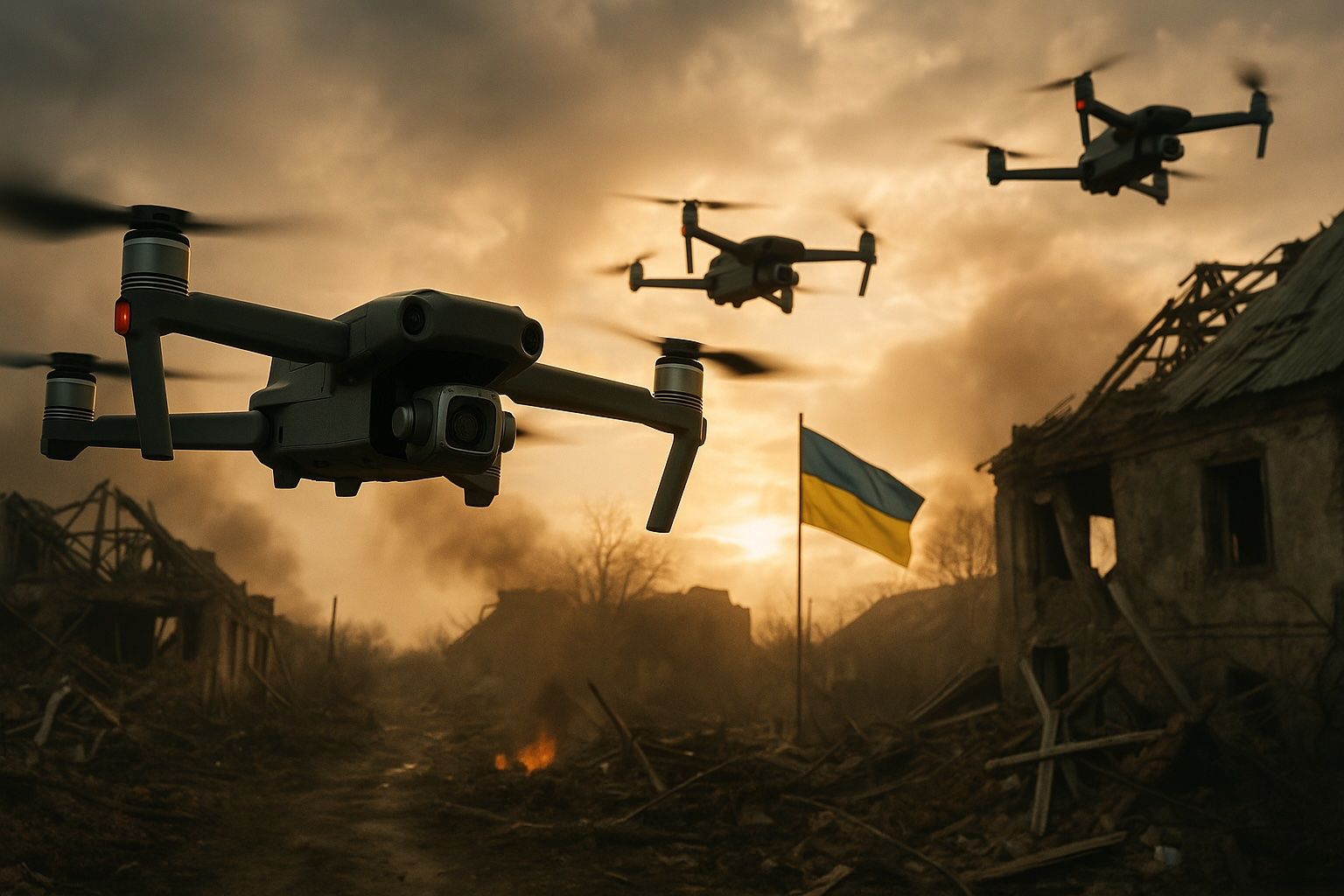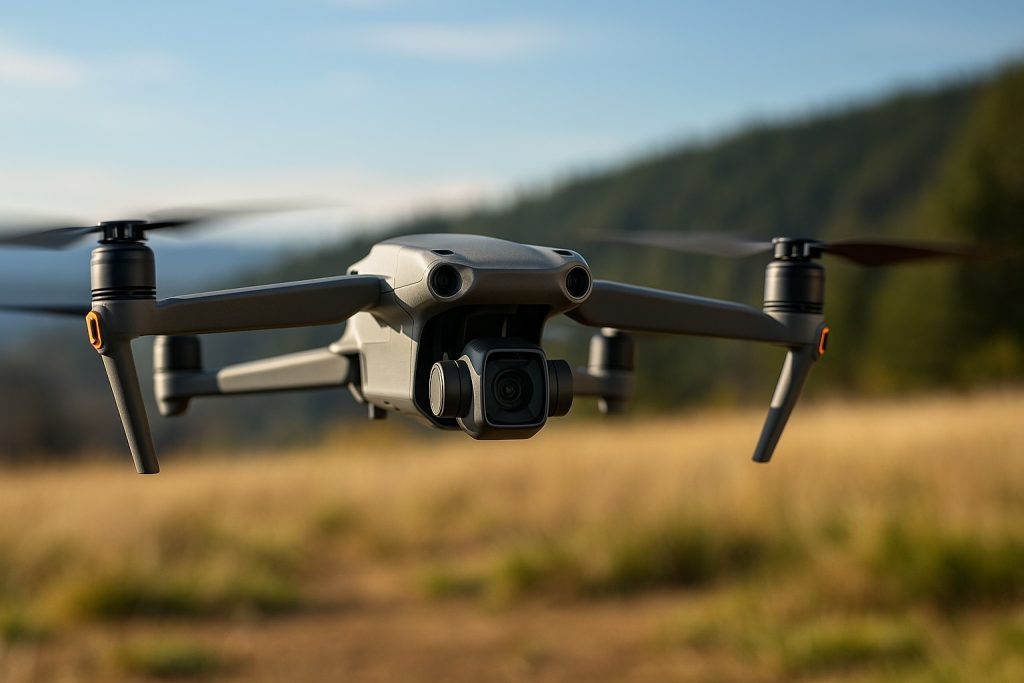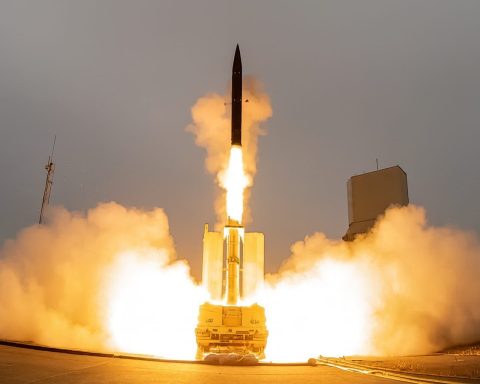- By late 2023, nearly every Ukrainian combat brigade had integrated drones, with dedicated UAV units for surveillance, artillery spotting, and attack missions.
- Small off-the-shelf DJI Mavic quadcopters, priced around $1,500–$3,000, were widely used for frontline reconnaissance and artillery correction.
- FPV kamikaze drones cost as little as $400–$500 to assemble and have been linked to a large share of Russian losses, with estimates of 60–80%.
- UkrJet’s UJ-22 has an 800 km range for long-range strikes, while Antonov’s Lyuty reportedly has a 750 km range and a sub-$200,000 price per unit.
- By end-2024 Ukraine conducted the world’s first fully unmanned joint attack coordinating ground robots and aerial FPV drones against a Russian position.
- The Army of Drones program launched in 2022 and the Brave1 defense incubator in 2023, with Brave1 funding 470+ projects totaling about ₴1.3 billion by February 2025.
- By February 2025, Ukraine could produce up to 4 million drones per year at full capacity, and the country had around 500 domestic drone manufacturers.
- Baykar delivered around 50 TB2 drones to Ukraine in 2022 and announced a $100 million investment to build a Baykar drone production plant in Ukraine, with construction starting in 2023.
- The United States supplied over 700 Switchblade loitering munitions and about 1,800 Phoenix Ghost drones to Ukraine by early 2023.
- Civilian and humanitarian drone use expanded to agriculture (PD-2 and Raybird-3 for crop monitoring) and medical deliveries (drones carrying up to 16 kg) along with disaster response missions such as flood relief after the Nova Kakhovka dam breach.
Introduction
The period from 2022 through 2025 has seen Ukraine transform into a focal point of drone deployment and innovation. Unmanned aerial vehicles (UAVs), commonly known as drones, have permeated nearly every aspect of Ukraine’s military, commercial, civilian, and humanitarian spheres. In the ongoing war sparked by the 2022 Russian invasion, drones became an indispensable asset on the battlefield, used in roles ranging from frontline reconnaissance and precision strikes to logistics and electronic warfare countermeasures. At the same time, Ukrainian society and industry have harnessed drone technology for non-military purposes – from farming and infrastructure monitoring to disaster relief and medical supply delivery. This report presents a formal overview of drone usage in Ukraine from 2022 through 2025, examining battlefield deployments, civilian applications, key manufacturers and suppliers (both domestic and foreign), the wartime evolution of Ukraine’s drone industry, and projections for future developments in both military and civilian domains.
Military Deployment of Drones in the War (2022–2025)
Ukrainian soldiers preparing a large quadcopter drone during combat operations. Drones have fundamentally reshaped military operations in Ukraine’s defense against Russian aggression. By late 2023, nearly every Ukrainian combat brigade had integrated drones into its force structure, with specialized UAV units for surveillance, artillery spotting, and attack missions [1] [2]. Small reconnaissance drones are ubiquitous on the front lines – many of them off-the-shelf quadcopters like the Chinese-made DJI Mavic, repurposed to give troops in trenches a live aerial view of the battlefield [3] [4]. These inexpensive quadcopters (costing only around $1,500–$3,000 each) have been invaluable for spotting enemy positions and guiding artillery fire [5] [6]. Larger fixed-wing recon drones with longer range and high-end cameras operate further from the front, scouting deep into enemy territory and feeding target coordinates into digital mapping systems like the Kropyva platform [7]. This persistent aerial surveillance – often operated by teams of civilian-trained drone pilots – has given Ukrainian forces superior situational awareness and targeting precision.
Combat and Strike Roles: Armed drones and loitering munitions have been deployed extensively by Ukraine for direct attack. In the initial stages of the war, the Turkish-made Bayraktar TB2 UAV captured world attention by destroying Russian armor and supply columns. At least 50 Bayraktar TB2s were supplied to Ukraine, and in the invasion’s early weeks these medium-altitude drones devastated Russian ground forces advancing toward Kyiv, boosting Ukrainian morale [8] [9]. However, as Russia adjusted its air defenses and electronic warfare tactics, the Bayraktar’s role shifted primarily to reconnaissance, and opportunities for its large-scale strike use declined later in the conflict [10]. By mid-2023, Ukrainian commanders noted it had become “hard to find situations where to use [TB2s]”, given the dense anti-air threat [11] [12]. Instead, Ukraine increasingly turned to smaller kamikaze drones and cheap munitions. The United States supplied Ukraine with hundreds of Switchblade loitering munitions and similar systems – over 700 Switchblade drones (both the small 300 model and larger anti-armor 600 model) and roughly 1,800 Phoenix Ghost tactical drones were committed by early 2023 [13]. These one-way attack drones can be tube-launched by troops and guided onto targets like tanks or artillery, exploding on impact. Likewise, Poland provided its WB Electronics Warmate loitering drones to Ukraine as part of military aid [14], and Britain/Norway donated micro Black Hornet drones (tiny palm-sized UAVs for recon and target spotting) to enhance infantry units’ close-range ISR capabilities [15] [16].
Perhaps the most game-changing has been Ukraine’s mass adoption of First Person View (FPV) kamikaze drones. These are cheap, fast quadcopters or small fixed-wings originally designed for hobby racing, now fitted with explosive payloads and cameras that feed a live video to a VR headset worn by the operator [17] [18]. FPV drones cost as little as $400–$500 to assemble (plus an attached grenade or warhead) [19] [20], yet they can destroy high-value assets like tanks or artillery worth millions [21] [22]. Operated in swarms by skilled pilots, FPV drones have been credited with inflicting a very large share of battlefield losses – by 2023 Ukrainian sources even estimated that up to 60–80% of certain Russian equipment losses were caused by small tactical drones [23] [24]. Every day, Ukrainian units release combat footage of $500 FPV drones diving into enemy armored vehicles with deadly effect [25] [26]. These drones are extremely difficult to defend against: they fly low and fast, and unlike artillery shells, they can chase moving targets with high accuracy [27]. Ukrainian assault units have also used commercial quadcopters adapted to drop grenades or mortar shells from the air – a tactic that keeps enemy troops constantly wary of the ominous buzz of drones overhead [28]. By late 2023 the deployment of small drones had become highly organized, with Ukraine standing up dedicated assault drone companies and nearly every infantry platoon fielding its own reconnaissance drones for local situational awareness [29] [30]. Notably, the government launched a crash program to produce drones domestically at scale – aiming for up to 1 million FPV drones in 2024 to meet frontline needs [31] [32]. By early 2025, Ukraine was reportedly manufacturing about 200,000 FPV drones per month as domestic companies ramped up output [33] [34].
Long-Range Strikes: Drones have also been used by both sides for strikes far beyond the front lines. In the autumn of 2022, Russia began deploying Shahed-136 loitering drones (supplied by Iran) in large numbers to attack Ukrainian cities and infrastructure [35] [36]. The Shahed-136 is a delta-wing “kamikaze” drone with a range of up to 2,500 km, a low radar signature, and a cost estimated under $100,000 – cheaper than most missiles [37] [38]. Flying autonomously on pre-programmed routes (often with erratic course changes to confuse defenders), swarms of Shaheds forced Ukraine to expend precious air-defense missiles or resort to shooting them down with machine guns [39] [40]. In response to these persistent drone barrages, Ukraine improvised tactics like mounting anti-aircraft guns on pickup trucks to intercept Shaheds [41] [42]. At the same time, Ukraine set out to develop its own long-range unmanned strike capability to hit targets deep inside Russia [43]. Early Ukrainian long-range drones often fell prey to Russian jamming and air defenses, but by late 2023 Ukraine began achieving success with homegrown systems [44] [45]. One example is the UJ-22 drone (by UkrJet), a propeller-driven UAV with an 800 km range, used to bomb fuel depots and bases across the border [46] [47]. Ukraine has also reportedly developed larger long-range drones like the “Lyuty” (fury) model by Antonov, roughly analogous to the Shahed in size and range [48] [49]. These deep-strike drones have been used to hit Russian military airfields, ammunition depots, and even oil infrastructure hundreds of kilometers away [50] [51]. In one instance, a Ukrainian long-range drone attack in January 2024 set fire to Novatek’s Ust-Luga fuel terminal in Russia, halting operations there for several days [52] [53]. President Zelensky has hailed Ukraine’s growing fleet of long-range UAVs as “a clear and effective guarantee” of security, as they enable striking back at threats previously out of reach [54] [55].
Electronic Warfare and Countermeasures: The intense drone duel over Ukraine has led to equally intense electronic warfare (EW) measures on both sides. Electronic jamming has proven the most effective way to stop drones mid-flight [56] [57]. Russian and Ukrainian forces saturate the front lines with EW systems that jam GPS signals or drone radio links, causing UAVs to lose control or video feed [58] [59]. This has become a high-tech cat-and-mouse game: as soon as drones shift to alternative control frequencies or encryption to evade jamming, adversaries adjust their EW tactics in response [60] [61]. Ukrainian drone pilots report that enemy jammers have forced them to constantly hop to new, less-common frequencies and to employ signal repeaters (sometimes lofted on another drone) to maintain control beyond line-of-sight [62] [63]. Both sides also use portable “anti-drone guns” at the infantry level – these devices emit directional jamming signals to down or disable small quadcopters threatening frontline troops [64] [65]. Ukrainian soldiers note that as Russian drones began shifting frequencies to counter Ukraine’s jammers, some of their older EW gear and homemade interceptors became less effective [66] [67]. By 2024, the electromagnetic environment at the front was extremely dense, with overlapping jamming zones that sometimes even impeded one’s own drones. To overcome the jamming threat, Ukraine and Russia have started developing next-generation drones that can operate with a high degree of autonomy or via unjammable control links. One approach is drones guided by artificial intelligence for target recognition and attack, so that no continuous radio control is needed during the terminal phase [68] [69]. Both sides have begun fielding a small number of drones with onboard AI that can identify a target (e.g. a vehicle) and then home in on it without further operator input [70] [71]. “You cannot jam such a drone, because there is nothing to jam,” explained one Ukrainian pilot of an AI-guided model, though experts caution the technology is still maturing [72] [73]. Another innovation has been the use of fiber-optic tethered drones – Russia introduced drones that trail a thin optical fiber cable, which relays control signals immune to radio jamming [74]. Ukraine is now racing to adopt similar fiber-optic drones to negate the enemy’s electronic interference [75]. These advances suggest that autonomy and novel control methods will shape the next chapter of drone warfare, as electronic countermeasures continue to proliferate [76] [77].
Logistics and Other Military Uses: While combat and surveillance have dominated, Ukraine has also explored drones for logistical support on the battlefield. Small multicopter drones have occasionally been used to carry ammunition, water, or medical supplies to platoons in difficult-to-reach forward positions, reducing risk to human couriers. The concept of larger cargo drones was in development even before the war (for example, Ukrainian startup Airlogix had a heavy lift drone project pre-2022) [78] [79]. After the invasion, Airlogix repurposed its technology into an ISR drone for the military, but it underscores the potential for drone-based resupply. So far, drone delivery in combat has been limited to ad-hoc short-range hops due to airspace control and payload limits. However, as Ukraine refines its unmanned systems, the armed forces are considering drone “mules” to ferry essentials across dangerous front-line zones, a tactic that could be expanded in the future.
Naval Drones: Ukraine also pioneered the use of unmanned surface vehicles (naval drones) during the conflict, adding a new dimension to drone warfare. Starting in 2022, Ukraine’s Navy and special forces deployed explosive-laden remote-controlled boats to attack Russian warships in the Black Sea. These marine drones successfully penetrated port defenses, damaging several Russian naval vessels and even sinking a few [80] [81]. The campaign of naval drone strikes helped force Russia’s Black Sea Fleet to retreat from ports in occupied Crimea, easing the blockade on Ukraine’s coastline [82] [83]. By removing or neutralizing threats at sea, these drones enabled the partial reopening of maritime routes for Ukrainian grain exports – a significant strategic and economic achievement [84] [85]. In late 2024 and early 2025, Ukraine began arming naval drones with missiles and anti-air weapons, essentially turning unmanned boats into mobile launch platforms [86] [87]. In a world-first feat, a missile-equipped Ukrainian naval drone reportedly shot down several Russian helicopters over the Black Sea in January 2025 [88] [89]. And in May 2025, Ukrainian officials announced that naval drones carrying anti-aircraft missiles had even downed two Russian fighter jets – a remarkable extension of drone capabilities across domains [90] [91]. These developments highlight Ukraine’s innovative use of drones not only in the air, but at sea and (increasingly) on land with ground robots, to offset Russia’s numerical advantages. In fact, by the end of 2024 Ukraine conducted the world’s first fully unmanned joint attack, coordinating ground robots and aerial FPV drones in an assault on a Russian position without any soldiers directly on the scene [92]. This milestone underscores how far Ukraine has pushed the envelope in integrating drones into warfare.
Civilian and Commercial Drone Use in Ukraine
Outside of direct combat, drones have found growing adoption in Ukraine’s civilian and commercial sectors, often accelerated by wartime innovation. Agriculture is a prime example: Ukrainian farmers are increasingly utilizing drones for crop monitoring, spraying, seeding, and other precision agriculture tasks. Before the war, agri-drones were an emerging trend; the conflict then supercharged Ukraine’s expertise in unmanned systems, which is now being repurposed to boost farming productivity [93] [94]. Drones developed for military reconnaissance are well-suited for agricultural surveying – for instance, the PD-2 unmanned aircraft from Ukrspecsystems (a surveillance drone with vertical takeoff ability and long endurance) can be outfitted to overfly large farm fields and collect data on crops [95] [96]. Another Ukrainian-made UAV, the Raybird-3 by Skyeton, offers 28-hour flight endurance and long range, originally intended for ISR missions but equally capable of day-long monitoring of expansive farmlands [97] [98]. Drones can also perform active agricultural work: the Skyfall “Vampire” drone, initially an FPV attack platform, can lift 15 kg of payload, making it useful for carrying fertilizer or seed for dispersal over fields [99] [100]. These examples show how designs born of warfare can pivot to peacetime uses. Major Ukrainian drone firms are already preparing civilian versions of their platforms; Ukrspecsystems and Skyeton, for example, have the engineering capacity and distribution networks to adapt their military-grade drones into farming tools on short notice [101] [102]. In addition, numerous smaller startups and legacy companies (like Athlon Avia, originally a military drone maker since 2014) are expected to enter the agricultural drone market, applying their advanced autopilot and sensor technologies to tasks like multispectral crop imaging and automated spraying [103].
Ukraine’s agricultural sector stands to gain a “drone dividend” after the war: drones can significantly increase yields and efficiency by monitoring crop health, precisely targeting pesticide use, and surveying large estates that face labor shortages [104]. The wartime leap in drone manufacturing has effectively positioned Ukraine to become a leading supplier of agri-drone technology across Europe. Ukrainian companies are already eyeing export opportunities in the EU and North Africa, where demand for precision agriculture is rising due to climate and water challenges [105] [106]. European agribusiness giants (like Bayer and Syngenta) are potential partners keen to integrate Ukraine’s high-end drone capabilities into their digital farming programs [107] [108]. In short, the same drones that have defended Ukraine’s fields from invaders may soon be deployed to improve those fields’ productivity.
Infrastructure and Industrial Applications: Drones have also become valuable for infrastructure monitoring and industrial inspection in Ukraine. Energy companies and civil engineers increasingly use UAVs to inspect power lines, railways, bridges, and buildings – a trend amplified by wartime needs. After Russian missile strikes or shelling, drones are sent to survey damage to critical infrastructure, allowing officials to assess impacts quickly and safely. For example, utility crews employ camera drones to examine hard-to-reach sections of blasted electrical transmission lines or to thermal-scan district heating pipelines for leaks, without waiting for demining teams to clear unexploded ordnance. This speeds up repairs to the war-damaged power grid and reduces risks to workers. Drones have also helped document damage to cultural heritage sites and residential areas for reconstruction planning. In industry, Ukrainian mining and metallurgy firms – traditionally big sectors – have begun using drones for tasks like mapping open-pit mines, monitoring stockpiles, and checking the integrity of industrial facilities (silos, smokestacks) that might have suffered wartime wear. All of these commercial uses were present in Ukraine to some degree before the war, but the conflict accelerated adoption by highlighting drones’ ability to operate in dangerous or hard-to-access environments where humans cannot. Notably, even journalists and media in Ukraine rely on drones: news organizations have used camera drones extensively to film war zones and civilian damage for the world to see [109] [110]. This provided real-time visuals of events, essentially turning drones into tools of public information. Overall, Ukraine’s experience has mainstreamed UAVs across its economy – what was once niche tech is now commonly recognized as a practical solution for many civilian needs.
Drone Delivery and Future Services: While large-scale drone delivery networks have not yet been established due to the conflict and airspace restrictions, there have been pilot efforts in Ukraine. Prior to the war, the national postal service and private couriers like Nova Poshta experimented with delivering parcels by drone between cities [111] [112]. Those tests (e.g. a drone flying parcels from Kyiv to Kharkiv in 2021) proved technically feasible. During the war, regular drone delivery services were paused, but drones have still been used for last-mile transport in emergency situations – a hint of their potential. For example, humanitarian groups employed drones to carry small critical loads (medicine, blood samples, etc.) to villages cut off by fighting. Some volunteer teams also rigged drones to drop food and supplies to civilians trapped in besieged zones when manned vehicles could not get through. Looking ahead, Ukraine is poised to revive and expand its drone logistics initiatives once skies are safe. The surge of local drone manufacturing and expertise means that domestic companies could field fleets of delivery drones for commercial use in the near future. We may see Ukrainian-made drones carrying e-commerce packages, medical prescriptions, or postal mail across the country – especially to remote rural communities with poor road access. In sum, the war impelled Ukraine to become adept at unmanned aviation out of necessity, and those skills are now spilling over into commercial and civil drone applications that will likely flourish in the post-conflict period.
Humanitarian and Emergency Applications of Drones
Drones have also played a critical humanitarian role in Ukraine, aiding in disaster response, search-and-rescue, medical aid, and demining efforts amid the destruction of war. In urban combat zones, where bombardments have reduced buildings to rubble, drones have been lifesavers for emergency services. Small search-and-rescue drones equipped with cameras and two-way audio have been used to locate survivors in partially collapsed structures without risking rescue personnel [113] [114]. These UAVs can fly into unstable ruins or high-rise apartments gutted by explosions, transmitting live video of trapped civilians and even allowing responders to talk with them via onboard speakers [115] [116]. American firms and charities donated specialized micro-drones for this purpose early in the war, and Ukrainian teams were trained in their use for urban search operations [117] [118]. The drones’ ability to enter confined spaces, peek under debris, and operate in toxic environments (like a shelled chemical plant) makes them ideal for disaster scenarios. Some models can even push open doors or flip themselves upright if they get knocked over, enabling navigation through cluttered wreckage [119]. This technology greatly improves the odds of finding survivors in the “golden hours” after an attack, without exposing firefighters or medics to unnecessary danger.
Another life-saving use has been the delivery of medical supplies by drone. Early in the conflict, the Ukrainian NGO “Revived Soldiers Ukraine” partnered with drone manufacturer Draganfly to deploy medical-response drones that carry medicines, blood, and first-aid to front-line and besieged areas [120] [121]. These drones can transport up to 16 kg (35 lbs) of critical supplies in special temperature-controlled payload boxes [122] [123]. Draganfly provided an initial fleet in spring 2022, and by mid-2022 it was expected that “a couple hundred” of such drones would be operating across Ukraine [124] [125]. The drones are programmed to drop their medical payload at designated GPS coordinates – they hover low for a moment and release the package, then quickly depart to avoid drawing fire [126] [127]. This method proved effective after operators learned that civilians were initially fearful to approach a landed drone, unsure if it was friendly or if the payload was safe [128]. With the new drop technique, drones have delivered everything from insulin and antibiotics to bandages and water in war-torn neighborhoods. “Medical Response and Search and Rescue Drones will play a crucial role in ensuring those affected have access to the aid they require,” noted one U.S. donor, underscoring their importance in hard-to-reach and high-risk zones [129] [130].
Drones have also been heroes in disaster relief operations unrelated to combat. A striking example occurred in June 2023, when the Nova Kakhovka Dam in southern Ukraine was destroyed, causing massive flooding. In the aftermath, Ukrainian authorities used drones to search for stranded civilians and deliver emergency supplies. Footage released by the army showed a drone lowering bottles of water to civilians trapped on rooftops by the floodwaters [131] [132]. In one video, a young boy clinging to a window was able to grab a water bottle dropped by the drone – an image that highlighted the life-saving potential of UAVs in crises [133] [134]. The family was later evacuated safely by boat, but it was the drone that provided their first vital relief [135]. Such drone missions filled in crucial gaps when regular rescue boats or vehicles could not immediately reach all victims in the vast flooded area. Similarly, during wildfires or accidents, drones have been used in Ukraine to overfly hazardous areas (like burning fuel depots) to assess conditions and direct firefighters, again keeping humans out of harm’s way.
A final and particularly important humanitarian application is demining – the removal of land mines and unexploded ordnance (UXO) from Ukraine’s soil. By 2023, Ukraine had become one of the most mine-contaminated countries in the world due to extensive use of mines and cluster munitions in the conflict. Here too, drones and AI technology are providing a breakthrough. Ukrainian and international teams are deploying drones with special sensors (magnetometers, ground-penetrating radar) and AI software to detect buried mines and mark their coordinates for removal [136] [137]. For instance, a startup project called Safe Pro AI uses machine learning on drone imagery to identify subtle indicators of mines or UXO in fields [138] [139]. Drones can scan large swaths of terrain far faster than manual detectors, and without endangering deminers. There are even experimental drones that drop small charges to safely detonate mines from the air once found. In addition, unmanned ground vehicles (land drones nicknamed “drone dogs”) are being tested to physically navigate minefields and neutralize explosives while human operators stand at a safe distance [140]. This marks a historic modernization of mine clearance, a field that had seen little innovation in decades [141] [142]. With an estimated 30% of Ukraine’s territory contaminated by explosives, these AI-powered demining drones are poised to greatly accelerate making farmland and communities safe again [143] [144]. International allies (including companies from Japan and the UK) are partnering with Ukraine to refine this technology and train demining units in drone use [145]. The integration of drones in humanitarian demining not only saves deminers’ lives but could eventually allow Ukraine to restore normal economic activity (like agriculture) on land that would otherwise stay off-limits for years.
In summary, drones in Ukraine have not only been instruments of war, but also instruments of humanity – finding survivors, delivering aid, and mending the wounds of war. These applications underscore the versatility of unmanned systems and provide a blueprint for how drones can assist in crises worldwide.
Key Drone Manufacturers and Suppliers (Domestic and Foreign)
Ukraine’s drone resurgence has been supported by a mix of domestic manufacturers rising to the challenge and foreign partners supplying critical systems and components. Below is an overview of key players and their roles in arming Ukraine’s drone forces:
Domestic Ukrainian Drone Manufacturers
Wartime necessity turned Ukraine into a hotbed of drone innovation, with hundreds of new local companies entering the industry. In fact, Ukraine’s Digital Transformation Ministry reported that by 2025 there were about 500 domestic drone manufacturers, up from only 7 manufacturers before the full-scale invasion [146] [147]. These range from small startups building hobbyist-style drones to established defense firms producing advanced UAV systems. Some of the most prominent Ukrainian manufacturers include:
- Ukrspecsystems – A veteran defense firm known for high-end UAVs. Key products: the PD-2 (a versatile mid-range reconnaissance drone with optional VTOL capability) and the Shark surveillance UAV. Ukrspecsystems specializes in robust, reusable drones for intelligence and artillery spotting; its systems like PD-2 have been widely used for long-range ISR and have even been adapted to carry small bombs [148]. The company has leveraged war demand to scale up production and even set up international distribution for civilian conversions of its drones [149] [150].
- Skyeton – Manufacturer of the Raybird-3 (ACS-3) long-endurance drone. Raybird is an advanced fixed-wing UAV with up to 28 hours endurance and 2,500 km range, used for deep reconnaissance [151] [152]. During the war, Skyeton’s Raybird helped Ukrainian artillery with aerial laser targeting and surveillance. A Raybird system (which includes multiple aircraft and ground control) sells for over $1 million, reflecting its sophistication [153] [154]. Skyeton is expected to pivot to international markets post-war with both military and civilian (e.g. patrol, survey) drone offerings.
- Antonov – Ukraine’s storied aircraft manufacturer (maker of the AN-series cargo planes) has also entered the drone arena. In 2023 Antonov unveiled the AN-196 “Lyuty”, a long-range strike drone analogous to Iran’s Shahed [155] [156]. The Lyuty (meaning “fierce”) reportedly has a range around 750 km and costs under $200,000 per unit [157] [158]. Russian reports have attributed to the Lyuty some of the drone strikes on oil depots inside Russia [159]. Antonov’s deep expertise in aerospace and its ties with state defense conglomerate Ukroboronprom give it a strong foundation to expand in the drone market. Notably, Antonov transitioned from state-owned to a private holding company in 2024, possibly to become more agile in ventures like UAV production [160].
- Vyriy – A Ukrainian startup (name derived from mythic paradise) that produces Molfar FPV drones. The Molfar is considered one of the best-performing first-person-view kamikaze drones on the front [161] [162]. Vyriy was an early mover in 2022 and achieved reliability in swarm production of small FPVs. The company has also led in adapting to EW threats: its drones operate on lower-frequency bands (sub-1 GHz) to resist jamming and detection [163] [164]. Vyriy is working to localize production of components (currently ~70% of its drone parts are made in Ukraine) [165] [166], and it announced in 2024 the first batches of entirely domestically-built FPVs including frames, electronics, and cameras [167] [168].
- Skyfall – A major FPV drone producer launched in mid-2022. Skyfall scaled up rapidly and produces large numbers of attack drones. Key models: Vampire (a heavy-lift FPV drone with ~15 kg payload) and Shrike. Skyfall kept a low profile but achieved mass-production efficiencies, making it a backbone supplier for Ukraine’s “Army of Drones.” Its Vampire drones have notably higher lift capacity than typical FPVs, allowing delivery of larger explosive charges or, in the future, civilian payloads [169] [170].
- TAF (Terminal Automatic Factory) – Believed to be one of the largest FPV drone manufacturers in Ukraine by volume. TAF builds standardized quadcopters (Kolibri series 7-inch, 8-inch, 10-inch) and was reportedly producing around 40,000 FPV drones per month as of early 2025 [171] [172]. TAF’s output, valued above $1 billion, underscores the scale of Ukraine’s drone industry surge.
- Athlon Avia – A company active since the earlier Donbas conflict (2014). Athlon’s signature product is the FuriaUAV, a long-range mini drone used for artillery spotting. It also developed Hrim/Thunder loitering drones. During the war, Furia drones provided reliable recon to the Ukrainian Army, and the company even began exporting some models abroad [173] [174]. Athlon contributes advanced avionics and autopilot systems and is part of the deep roster of Ukraine’s indigenous UAV know-how.
- UkrJet – Producer of the UJ-22 Airborne and larger UJ-26 (code-named Bober, or “Beaver”). UkrJet started serial production of its drones right after the invasion in 2022 [175]. The UJ-22 is a small propeller-driven UAV that Ukraine has used for long-range strikes (it infamously crashed near Moscow in 2023 during an attempted strike). UkrJet’s designs share some heritage with Ukrspec (overlapping leadership) [176] [177], and they emphasize range and payload for one-way attack missions.
- Terminal Autonomy – An example of an innovative newcomer with international backing. It makes the AQ-100and AQ-400 “Scythe” drones – relatively inexpensive fixed-wing kamikaze drones built from plywood for low cost [178] [179]. The AQ-400 has a range of ~750 km and costs only about $30k, making it one of the cheapest long-distance strike drones available [180] [181]. Terminal Autonomy was shipping over 1,000 drones per month by late 2023, showing how even lesser-known firms scaled to meet war demand [182] [183].
- Airlogix – A firm that started with cargo drones but pivoted to military. Its flagship GOR drone is a robust ISR quadcopter with 4-hour endurance and a ~$200k price tag [184] [185]. Airlogix reportedly delivered 500 units of GOR in 2024 (about $100 million in sales) as demand soared [186] [187]. The company is rumored to be developing a deep-strike drone as well [188]. Airlogix’s origins in heavy lift and logistics drones hint at the future civilian uses it may return to post-war.
(The above are just a selection of leading domestic players; in total, Ukraine’s drone industry encompasses hundreds of manufacturers, many of which have grown out of volunteer groups or small startups into significant enterprises.) The Ukrainian government has actively fostered this growth, simplifying procurement and certification for new UAV models. It launched the “Army of Drones” program in 2022 to crowdfund and indigenize drone production [189], and the Brave1 defense tech incubator in 2023 to provide grants and R&D support to drone innovators [190] [191]. As a result, Ukraine now boasts what officials call the world’s largest production capacity for certain classes of drones (tactical and long-range) [192] [193], with the vast majority of drones used by Ukraine in 2024 being made domestically [194] [195]. This domestic industry is set not only to supply Ukraine’s own needs but also to become a major exporter in the future once wartime export restrictions are eased [196] [197].
Foreign Drone Suppliers to Ukraine
International partners have been crucial in arming Ukraine with drones and related technology, especially early in the war before local production ramped up. Key foreign suppliers and manufacturers include:
- Baykar (Turkey) – Manufacturer of the Bayraktar TB2 drone, which became iconic in Ukraine’s defense. Baykar delivered around 50 TB2 drones to Ukraine in 2022 [198] [199], and these were used effectively against Russian forces in the war’s opening phase. Baykar is now deepening its partnership with Ukraine: in late 2023 the company announced a $100 million investment to build a Baykar drone production plant in Ukraine, including a service center and training hub [200] [201]. Construction began with plans to produce not only TB2s but also Baykar’s newer Akıncı heavy combat drone on Ukrainian soil [202] [203]. This long-term cooperation underscores that Baykar views Ukraine as a strategic partner, not just an arms client [204].
- AeroVironment (United States) – A key American UAV manufacturer whose loitering munitions were supplied to Ukraine. AeroVironment’s Switchblade drones (300 and 600 models) have been extensively used by Ukrainian troops for one-way strike missions. The U.S. provided over 700 Switchblade drones to Ukraine [205], alongside training to operate them. Additionally, the U.S. sent ~1,800 of the secretive Phoenix Ghost loitering drones [206], developed in cooperation with Ukraine, which are believed to have capabilities similar to Switchblade. AeroVironment also makes small RQ-20 Puma and RQ-11 Raven recon drones; dozens of these hand-launched scout drones have been delivered to Ukraine via U.S. security aid to enhance platoon-level ISR. In 2023, the U.S. began contracting for newer systems (like the JUMP 20 VTOL drone and ALTIUS-600) to be procured for Ukraine as well [207] [208].
- Teledyne FLIR (USA/Norway) – Producer of the Black Hornet nano-drone. These tiny (16 cm) helicopter drones are used for reconnaissance inside buildings or over ridges. In August 2022, the UK and Norway jointly donated a package of Black Hornet micro-drones worth 90 million NOK (about $9.3M) to Ukraine [209] [210]. The Black Hornets have given Ukrainian patrols a stealthy way to peek at enemy positions around corners or search for targets in urban combat, essentially serving as a soldier’s personal “spy in the sky.” The donation exemplified allied support in providing cutting-edge tech for troop safety.
- DJI (China) – Although not a state-backed donation, the Chinese company DJI’s commercial quadcopters (Mavic, Phantom, Matrice series) have been a staple on both sides of the war. Ukrainian forces rely heavily on DJI Mavicdrones for short-range reconnaissance and artillery correction [211] [212]. These consumer drones are affordable, easy to operate, and widely available – making them a convenient choice for an army suddenly in need of aerial eyes. However, reliance on Chinese drones raised concerns: at the war’s outset, Ukraine’s military “relied on Chinese-manufactured drones” for many tasks [213] [214]. Technical and security issues arose (e.g. DJI’s drone detection system could potentially be used by Russia to track Ukrainian drone pilots). As the war progressed, Ukraine pushed to reduce dependence on foreign off-the-shelf drones by boosting local production and by sourcing components elsewhere. Still, tens of thousands of DJI drones have been employed in Ukraine, funded by volunteer donations and government purchases, underscoring their role as an inadvertent foreign supplier of vital equipment.
- WB Group (Poland) – Poland has been a strong defense supporter of Ukraine, including providing drones. Polish firm WB Electronics supplied its Warmate loitering munitions to Ukraine via military aid and fundraising campaigns [215]. Warmate drones (sometimes called “Polish kamikaze drones”) carry a 1–1.5 kg warhead and are capable of striking targets several kilometers away. Ukraine received multiple batches of Warmates from Poland and even Lithuania (which funded some units for Ukraine) [216]. Additionally, Poland transferred surveillance drones like the FlyEye (also by WB Group) which Ukrainian forces have used for reconnaissance and target acquisition since the early conflict in Donbas. These Polish-supplied drones have complemented Ukraine’s arsenal by adding diversity and additional quantities of loitering weapons.
- United States, United Kingdom, and Others – Beyond AeroVironment and FLIR, several Western countries have contributed drones or drone-adjacent support. The UK provided extremely short-range “micro” drones like the Black Hornet as noted, and also larger unarmed UAVs for surveillance. For instance, the UK sent Malloy heavy-lift drones for testing logistics roles and ScanEagle surveillance drones (15 systems were in one US aid package) [217]. Germany supplied some Luna x-2000 reconnaissance drones and vector UAVs as part of military aid. The Netherlands and Czech Republic funded kamikaze drones for Ukraine (the Czech “Bivoj” drone project, etc.). Each allied contribution, whether small quadcopters, mid-size ISR drones or loitering munitions, filled important niches in Ukraine’s drone ecosystem.
- Private Donors and Crowdfunded Drones – Uniquely, many drones have reached Ukraine through private or crowdfunded initiatives abroad. A famous episode was the Lithuanian public raising funds in 2022 to buy a Bayraktar TB2 for Ukraine – Baykar ultimately donated the drone free of charge and the money was used for other aid. Similar campaigns in Poland, Latvia, and elsewhere raised millions of euros for purchasing DJI drones, FPV drones, and components to send to Ukrainian units. These grassroots efforts effectively made civilians in foreign countries “suppliers” of drones to Ukraine, showing the global support harnessed via technology.
- Other Notable Foreign Inputs: Israel officially maintained a neutral stance and did not export military drones to Ukraine, but Ukrainian forces have reportedly acquired some Israeli-made UAVs (like the FlyEye’s Israeli equivalent or anti-drone systems) via third parties. Additionally, Canada’s Draganfly provided humanitarian drones as discussed, and Japan has offered to provide industrial drones for demining purposes in a business initiative [218]. Even before the war, Ukraine had imported some combat drones like the Turkish STM Kargu loitering munition and examined procuring U.S. MQ-1C Gray Eagle or MQ-9 Reaper drones – though the U.S. did not approve transfer of the large Gray Eagles during the war due to escalation concerns. Nonetheless, discussions about such systems spurred investment in Ukraine’s own long-range drones as an alternative.
In summary, Ukraine’s drone capability has been a joint effort: domestic industry provided agility and quantity, while foreign partners supplied technology and stopgap hardware when Ukraine needed it most. This collaboration has equipped Ukraine with a diverse drone fleet unmatched by any other active conflict.
Evolution of Ukraine’s Drone Industry During the War
The war years 2022–2025 have seen Ukraine’s drone industry evolve from a nascent sector to a booming powerhouse. Before 2022, Ukraine had only a handful of drone producers, mostly small enterprises or defense research units with limited output. The full-scale invasion, however, served as an urgent catalyst for change. In the span of three years, Ukraine achieved skyrocketing production capacity, technological advancement, and significant investment in unmanned systems [219] [220]. What was once “workshop tinkering” with repurposed commercial drones swiftly transformed into organized mass production of a wide array of UAVs [221] [222].
One measure of this transformation is sheer volume: Ukraine’s Defense Minister stated that Ukraine has become the world’s largest producer of tactical and long-range drones by quantity [223] [224]. Ukrainian factories and workshops collectively produced over 2 million drones in 2024, according to official figures – a stunning jump from only a few thousand domestic drones in 2022 [225] [226]. Monthly output of simple FPV drones climbed from ~20,000 units in early 2024 to 200,000 units per month in 2025 as manufacturing processes improved [227] [228]. President Zelensky announced in February 2025 that Ukraine could now produce up to 4 million drones per year at full capacity [229] [230] – indicating a scale that rivals or exceeds most NATO countries’ drone industries. This surge was enabled by quickly expanding the domestic industrial base: by 2025 approximately 500 companies were building drones or drone components in Ukraine, as noted, compared to just 7 companies pre-war [231] [232]. In effect, a whole new defense-tech sector was born under fire.
Crucially, Ukraine worked to localize production and reduce reliance on foreign parts, addressing early vulnerabilities (like dependency on Chinese hobby components). The government provided incentives for localization – for example, offering long-term contracts to manufacturers whose drones use >50% Ukrainian-made components [233] [234]. This led to rapid progress: companies such as Vyriy achieved 70% local sourcing and even delivered batches of drones built entirely with domestically-produced frames, electronics, engines, and thermal cameras by 2024 [235] [236]. Such strides not only mitigate supply chain risks but also allow Ukrainian engineers to customize drones to the specific needs of the battlefield (e.g. tuning communication links to niche frequencies to counter jamming) [237] [238]. The government’s push included streamlining regulatory hurdles and injecting capital – through the Brave1 initiative, Ukraine issued over $8 million in grants to drone startups in 2023 and early 2024 [239] [240]. By February 2025, Brave1 had funded 470+ projects with about ₴1.3 billion (Ukrainian hryvnia) in grants to spur R&D and production [241] [242]. These policies, combined with the passion of Ukraine’s tech-savvy workforce, fueled an “innovation wave” where new drone models and upgrades were designed, tested, and fielded in a matter of months – a pace much faster than traditional military procurement cycles [243] [244].
Another aspect of the industry’s evolution is qualitative improvement in drone effectiveness. Wartime feedback from the front lines drove iterative design changes. Early in the war, many drones had low success rates – as few as 30% of drones might survive to hit their target [245] [246]. By 2024, the success rate of higher-end Ukrainian drones reportedly climbed to ~70% on average [247] [248]. This was due to better engineering (more reliable electronics, better anti-jam measures) and improved tactics/training for operators. At the same time, the proliferation of drones meant that even if individually many failed or were shot down, enough would get through to make a decisive impact. Ukrainian commanders have noted that simply deploying drones in huge quantities can overwhelm defenses – “quantity has a quality of its own,” as one commander quipped [249] [250]. By saturating the front with many inexpensive FPVs, Ukraine compensated for any decline in per-drone survivability caused by improved Russian EW [251] [252]. This dual approach of raising quality and quantity in tandem has been a hallmark of Ukraine’s drone strategy.
The drone industry’s growth was not without challenges. By late 2024, it became apparent that production capacity was outpacing immediate frontline demand – a “surplus of supply” emerged for certain drone types [253] [254]. While Ukrainian volunteer groups and the government were buying drones as fast as possible, they still couldn’t purchase all units rolling off assembly lines, and some factories reported operating at only ~37% capacity due to lack of orders [255] [256]. To address this, Ukraine started formulating plans to open up export markets even before the war fully ends [257] [258]. Proposed scenarios included allowing vetted exports of drones to allied countries, with part of revenues reinvested into Ukraine’s armed forces [259] [260]. Such measures would prevent the nascent industry from stalling and ensure Ukraine can economically sustain its drone makers. Another challenge has been security: Ukraine’s drone factories and R&D centers have themselves become targets of Russian long-range strikes and espionage [261] [262]. To mitigate this, some manufacturers are decentralizing production across multiple small sites and implementing secrecy around locations to avoid being easily targeted [263] [264]. The government is also looking at strengthening counter-intelligence to prevent Russian sabotage or infiltration in the booming drone sector.
Despite the challenges, Ukraine’s wartime drone enterprise has laid the groundwork for a powerful high-tech industry in the long term. Officials now speak of Ukraine becoming a “Silicon Valley of defense technology” – leveraging the innovative spirit seen in its drone programs to attract global investment and talent in the post-war era [265] [266]. Uncrewed vehicles (aerial, ground, and naval) are identified as a top priority for Ukraine’s economic development strategy moving forward [267] [268]. In essence, a field that scarcely existed in Ukraine a few years ago is now deemed strategic for the country’s future, both for national security and export potential. The war has rewritten the rules of military procurement in Ukraine, proving that local tech companies – with proper support – can deliver solutions faster and sometimes superior to foreign imports. This represents a dramatic evolution from Ukraine being an importer of drones to an exporter and leader in drone warfare technology.
Future Outlook: Anticipated Developments in Military and Civil Drone Use
As Ukraine looks beyond 2025, both its armed forces and civilian sectors are charting ambitious plans for drones. The experiences of war have offered painful lessons and rapid advancements that will shape future deployment of unmanned systems. Below are some key projections for what lies ahead in Ukraine’s drone landscape:
- Next-Generation Military Drones (Autonomy and AI): The intense electronic warfare in Ukraine has made one thing clear – drones that can operate independently of radio links will dominate future battlefields. Ukraine is expected to accelerate development of AI-guided drones that can conduct missions with minimal human control [269] [270]. These drones would use onboard processors to recognize targets (tanks, radars, etc.) and make targeting decisions in real-time. A handful of such models have already been tested by Ukraine in 2024, and both Ukraine and Russia plan to expand their use after seeing that “you cannot jam such a drone” once it’s on autonomous seek-and-destroy mode [271] [272]. By late 2025 and beyond, we can expect Ukraine’s military to field much larger numbers of semi-autonomous loitering munitions and “hunter-killer” drones, possibly in coordinated swarms. In parallel, there will be more adoption of fiber-optic tethered control for drones, since these proved effective against EW in Russian hands [273]. Ukrainian firms are already prototyping drones that spool out a communication fiber, allowing secure control for dozens of kilometers without radio emissions. NATO militaries are closely watching these innovations – Ukraine’s advances are likely to influence NATO doctrine, with the alliance even considering building its own “drone wall” of defenses inspired by Ukraine’s 15-km deep drone kill-zones on the front [274] [275].
- Expansion of Drone Types (Ground and Sea Robots): The concept of unmanned warfare in Ukraine will broaden. Having proven aerial and naval drones in combat, Ukraine is now investing in unmanned ground vehicles (UGVs) for roles like logistical resupply, reconnaissance, and even direct combat. The Brave1 defense tech cluster is supporting dozens of robotic ground systems – from small bomb-disposal robots to unmanned tanks – with the goal of taking soldiers out of some of the most dangerous tasks [276] [277]. By the late 2020s, Ukrainian brigades may have entire platoons of ground drones working in tandem with aerial drones. For naval warfare, Ukraine will build on its success by developing faster and more autonomous naval drones, possibly including submersibles for stealth approach. The startling successes in 2025 (shooting down aircraft using naval drones as platforms) will drive further creativity in how drones of different domains (air/sea/land) can network and coordinate their attacks. Ukrainian military thinkers like General Zaluzhny have openly said that future victories will depend on “drones, electronic warfare, and artificial intelligence”, and that those who invest in tech will win wars [278] [279]. This vision is guiding Ukrainian R&D to ensure the country never again falls behind in unmanned capabilities.
- Integrated Air Defense vs. Drones: On the flip side, Ukraine will also be focusing on counter-drone measures, as the threat from hostile drones (like Russian Shaheds or Lancet strike drones) remains high. We can expect Ukraine to deploy layered air defense specifically tuned for drones – including more radio-frequency jammers, laser-based anti-drone weapons, and perhaps drone-on-drone interceptors. Already, Ukraine has used electronic “guns” and captured enemy drones by hacking their control. In the future, autonomous friendly drones might patrol and intercept hostile ones (drone dogfights in the sky). The lessons from defending against mass Shahed attacks – such as using cheaper anti-drone munitions and physical barriers (nets, decoys) – will likely lead to new systems that Ukraine might even export, given its firsthand experience in this area [280] [281].
- Post-War Civilian Boom: In the civilian realm, the end of the war will open Ukrainian skies for a drone boom in commerce and services. The Ukrainian government is keen to leverage the wartime tech gains to modernize industries at home. We will likely see widespread use of drones in agriculture – Ukraine can emerge as a leader in agri-tech by manufacturing advanced crop-spraying and farm surveillance drones and selling these globally [282] [283]. Many Ukrainian drone makers are already positioning “dual-use” models that can be sold for farming or environmental monitoring (which face fewer export controls than attack drones) [284] [285]. This could help Ukraine’s war-tested drone companies tap into a huge market and become an engine of economic recovery. Infrastructure reconstruction will also heavily involve drones: when rebuilding thousands of destroyed homes, schools, and bridges, drones will be used for surveying damage, architectural planning, and even transporting construction materials to hard-to-reach spots. Companies might deploy drone fleets to 3D-map devastated cities as a prelude to reconstruction efforts.
- Drone Logistics and Urban Air Mobility: Ukraine’s postal and logistics firms are expected to resume and expand drone delivery programs that were halted by war. Given the public familiarity with drones now, acceptance of delivery drones (for mail, e-commerce, medical supplies) is likely to be higher than in many countries. By late 2020s, Ukraine could institute regional drone delivery routes, connecting rural villages to urban centers for rapid transport of goods. Additionally, Ukraine may explore urban air mobility innovations (such as drone taxis or ambulance drones) as part of modernization – ideas that seemed futuristic a few years ago but are more conceivable after seeing large drones perform under stress in war. Ukraine’s legal and regulatory framework will need updates to safely integrate widespread drone traffic (lessons from wartime airspace control will be relevant here).
- Global Export and Cooperation: A major part of the future for Ukraine’s drone sector is export and international cooperation. Ukrainian drone makers hope to sell abroad once conditions allow [286] [287]. We can expect Ukraine to become an exporter of military drones to countries that watched the performance of Ukrainian UAVs with interest. Nations in Eastern Europe, Asia, and Africa might purchase Ukrainian drones as cost-effective alternatives to more expensive Western systems. In the civilian drone market too, Ukraine could export agricultural and industrial drones, competing with Chinese dominance by offering battle-proven durability and European safety standards. The Ukrainian government is already positioning to support this with trade promotion and possibly joint ventures. For instance, plans are underway to establish joint R&D hubs in Ukraine with EU partners to further drone tech for peaceful uses [288]. Ukraine’s integration into European standards (through EU candidacy) will also help its tech companies collaborate and sell in Europe’s single market in the future.
- Continued Innovation and “Drone Valley”: Finally, Ukraine’s trajectory suggests it will continue to innovate in unmanned tech even after the shooting stops. The conditions of war forced rapid problem-solving – from AI targeting to wooden drone airframes – and this spirit is likely to continue in peacetime start-ups. The Ukrainian government’s vision of a “Defense Tech Silicon Valley” implies sustained support for R&D, incubators, and attracting foreign talent [289] [290]. Future developments could include stealthier drones (with low radar/thermal signatures), supersonic drones (for faster strike capabilities), and integration of drones into a comprehensive digital battlefield network. Ukrainian universities and companies are apt to spin off expertise in related fields like robotics, space launch (for deploying surveillance drones or satellites), and AI software – meaning the drone revolution in Ukraine could broaden into a general high-tech renaissance.
In conclusion, Ukraine’s use of drones from 2022 to 2025 has not only been transformative in the context of the war but has also set the stage for lasting change in both military affairs and civilian life. Drones helped Ukraine compensate for conventional disadvantages on the battlefield, and in doing so, Ukraine became an innovator and large-scale producer of unmanned systems. This period effectively rewrote the manual on modern drone warfare – a legacy that Ukraine will carry forward in defending its nation and developing its economy. As General Zaluzhny observed, warfare has been “completely changed” by the Russian-Ukrainian War, and going forward victory will depend on outpacing the enemy technologically [291] [292]. Ukraine appears poised to embrace that challenge, ensuring that the drones that guarded its freedom in war will also help secure its prosperity and security in peace.
Sources: The information in this report is drawn from a range of defense analysis, news reports, and expert assessments from 2022–2025, including Reuters, Atlantic Council, Kyiv Post, DefenseScoop, CleanTechnica, and others, as cited in-line. All citations are provided in the format 【source†lines】 for verification of quoted and specific data.
References
1. www.reuters.com, 2. www.reuters.com, 3. www.reuters.com, 4. www.reuters.com, 5. www.reuters.com, 6. www.reuters.com, 7. www.reuters.com, 8. www.businessinsider.com, 9. www.businessinsider.com, 10. www.businessinsider.com, 11. www.businessinsider.com, 12. www.businessinsider.com, 13. defensescoop.com, 14. en.wikipedia.org, 15. www.reuters.com, 16. www.reuters.com, 17. www.reuters.com, 18. www.reuters.com, 19. www.reuters.com, 20. www.reuters.com, 21. www.reuters.com, 22. www.reuters.com, 23. georgetownsecuritystudiesreview.org, 24. georgetownsecuritystudiesreview.org, 25. www.reuters.com, 26. www.reuters.com, 27. www.reuters.com, 28. www.reuters.com, 29. www.reuters.com, 30. www.reuters.com, 31. www.reuters.com, 32. www.reuters.com, 33. www.atlanticcouncil.org, 34. www.atlanticcouncil.org, 35. www.reuters.com, 36. www.reuters.com, 37. www.reuters.com, 38. www.reuters.com, 39. www.reuters.com, 40. www.reuters.com, 41. www.reuters.com, 42. www.reuters.com, 43. www.reuters.com, 44. www.reuters.com, 45. www.reuters.com, 46. www.reuters.com, 47. www.reuters.com, 48. www.uasvision.com, 49. www.uasvision.com, 50. www.atlanticcouncil.org, 51. www.atlanticcouncil.org, 52. www.reuters.com, 53. www.reuters.com, 54. www.atlanticcouncil.org, 55. www.atlanticcouncil.org, 56. www.reuters.com, 57. www.reuters.com, 58. www.reuters.com, 59. www.reuters.com, 60. www.reuters.com, 61. www.reuters.com, 62. www.reuters.com, 63. www.reuters.com, 64. www.reuters.com, 65. www.reuters.com, 66. www.reuters.com, 67. www.reuters.com, 68. www.reuters.com, 69. www.reuters.com, 70. www.reuters.com, 71. www.reuters.com, 72. www.reuters.com, 73. www.reuters.com, 74. www.atlanticcouncil.org, 75. www.atlanticcouncil.org, 76. www.reuters.com, 77. www.reuters.com, 78. www.uasvision.com, 79. www.uasvision.com, 80. www.atlanticcouncil.org, 81. www.atlanticcouncil.org, 82. www.atlanticcouncil.org, 83. www.atlanticcouncil.org, 84. www.atlanticcouncil.org, 85. www.atlanticcouncil.org, 86. www.atlanticcouncil.org, 87. www.atlanticcouncil.org, 88. www.atlanticcouncil.org, 89. www.atlanticcouncil.org, 90. www.atlanticcouncil.org, 91. www.atlanticcouncil.org, 92. www.atlanticcouncil.org, 93. cleantechnica.com, 94. cleantechnica.com, 95. cleantechnica.com, 96. cleantechnica.com, 97. cleantechnica.com, 98. cleantechnica.com, 99. cleantechnica.com, 100. cleantechnica.com, 101. cleantechnica.com, 102. cleantechnica.com, 103. cleantechnica.com, 104. cleantechnica.com, 105. cleantechnica.com, 106. cleantechnica.com, 107. cleantechnica.com, 108. cleantechnica.com, 109. www.captechu.edu, 110. www.captechu.edu, 111. archive.kyivpost.com, 112. archive.kyivpost.com, 113. www.captechu.edu, 114. www.captechu.edu, 115. www.captechu.edu, 116. www.captechu.edu, 117. www.captechu.edu, 118. www.captechu.edu, 119. www.captechu.edu, 120. www.nationaldefensemagazine.org, 121. www.nationaldefensemagazine.org, 122. www.nationaldefensemagazine.org, 123. www.nationaldefensemagazine.org, 124. www.nationaldefensemagazine.org, 125. www.nationaldefensemagazine.org, 126. www.nationaldefensemagazine.org, 127. www.nationaldefensemagazine.org, 128. www.nationaldefensemagazine.org, 129. www.captechu.edu, 130. www.captechu.edu, 131. www.telegraph.co.uk, 132. www.telegraph.co.uk, 133. www.telegraph.co.uk, 134. www.telegraph.co.uk, 135. www.telegraph.co.uk, 136. www.jmu.edu, 137. www.jmu.edu, 138. spectrum.ieee.org, 139. dronelife.com, 140. www.jmu.edu, 141. www.jmu.edu, 142. www.jmu.edu, 143. inkstickmedia.com, 144. inkstickmedia.com, 145. www.kyivpost.com, 146. georgetownsecuritystudiesreview.org, 147. georgetownsecuritystudiesreview.org, 148. www.uasvision.com, 149. cleantechnica.com, 150. cleantechnica.com, 151. www.unmannedsystemstechnology.com, 152. fuelcellsworks.com, 153. www.uasvision.com, 154. www.uasvision.com, 155. www.uasvision.com, 156. www.uasvision.com, 157. www.uasvision.com, 158. www.uasvision.com, 159. www.uasvision.com, 160. www.uasvision.com, 161. www.uasvision.com, 162. www.uasvision.com, 163. www.uasvision.com, 164. www.uasvision.com, 165. georgetownsecuritystudiesreview.org, 166. georgetownsecuritystudiesreview.org, 167. georgetownsecuritystudiesreview.org, 168. georgetownsecuritystudiesreview.org, 169. cleantechnica.com, 170. cleantechnica.com, 171. www.uasvision.com, 172. www.uasvision.com, 173. www.uasvision.com, 174. www.uasvision.com, 175. www.uasvision.com, 176. www.uasvision.com, 177. www.uasvision.com, 178. www.uasvision.com, 179. www.uasvision.com, 180. www.uasvision.com, 181. www.uasvision.com, 182. www.uasvision.com, 183. www.uasvision.com, 184. www.uasvision.com, 185. www.uasvision.com, 186. www.uasvision.com, 187. www.uasvision.com, 188. www.uasvision.com, 189. georgetownsecuritystudiesreview.org, 190. georgetownsecuritystudiesreview.org, 191. georgetownsecuritystudiesreview.org, 192. georgetownsecuritystudiesreview.org, 193. georgetownsecuritystudiesreview.org, 194. georgetownsecuritystudiesreview.org, 195. georgetownsecuritystudiesreview.org, 196. www.uasvision.com, 197. www.uasvision.com, 198. euromaidanpress.com, 199. euromaidanpress.com, 200. www.businessinsider.com, 201. www.businessinsider.com, 202. www.businessinsider.com, 203. www.businessinsider.com, 204. www.businessinsider.com, 205. defensescoop.com, 206. defensescoop.com, 207. defensescoop.com, 208. defensescoop.com, 209. www.reuters.com, 210. www.reuters.com, 211. www.reuters.com, 212. www.reuters.com, 213. georgetownsecuritystudiesreview.org, 214. georgetownsecuritystudiesreview.org, 215. en.wikipedia.org, 216. en.wikipedia.org, 217. defensescoop.com, 218. www.kyivpost.com, 219. georgetownsecuritystudiesreview.org, 220. georgetownsecuritystudiesreview.org, 221. www.uasvision.com, 222. www.uasvision.com, 223. georgetownsecuritystudiesreview.org, 224. georgetownsecuritystudiesreview.org, 225. georgetownsecuritystudiesreview.org, 226. georgetownsecuritystudiesreview.org, 227. georgetownsecuritystudiesreview.org, 228. georgetownsecuritystudiesreview.org, 229. georgetownsecuritystudiesreview.org, 230. georgetownsecuritystudiesreview.org, 231. georgetownsecuritystudiesreview.org, 232. georgetownsecuritystudiesreview.org, 233. georgetownsecuritystudiesreview.org, 234. georgetownsecuritystudiesreview.org, 235. georgetownsecuritystudiesreview.org, 236. georgetownsecuritystudiesreview.org, 237. georgetownsecuritystudiesreview.org, 238. georgetownsecuritystudiesreview.org, 239. georgetownsecuritystudiesreview.org, 240. georgetownsecuritystudiesreview.org, 241. georgetownsecuritystudiesreview.org, 242. georgetownsecuritystudiesreview.org, 243. www.atlanticcouncil.org, 244. www.atlanticcouncil.org, 245. georgetownsecuritystudiesreview.org, 246. georgetownsecuritystudiesreview.org, 247. georgetownsecuritystudiesreview.org, 248. georgetownsecuritystudiesreview.org, 249. georgetownsecuritystudiesreview.org, 250. georgetownsecuritystudiesreview.org, 251. georgetownsecuritystudiesreview.org, 252. georgetownsecuritystudiesreview.org, 253. georgetownsecuritystudiesreview.org, 254. georgetownsecuritystudiesreview.org, 255. georgetownsecuritystudiesreview.org, 256. georgetownsecuritystudiesreview.org, 257. georgetownsecuritystudiesreview.org, 258. georgetownsecuritystudiesreview.org, 259. georgetownsecuritystudiesreview.org, 260. georgetownsecuritystudiesreview.org, 261. georgetownsecuritystudiesreview.org, 262. georgetownsecuritystudiesreview.org, 263. georgetownsecuritystudiesreview.org, 264. georgetownsecuritystudiesreview.org, 265. georgetownsecuritystudiesreview.org, 266. georgetownsecuritystudiesreview.org, 267. georgetownsecuritystudiesreview.org, 268. georgetownsecuritystudiesreview.org, 269. www.reuters.com, 270. www.reuters.com, 271. www.reuters.com, 272. www.reuters.com, 273. www.atlanticcouncil.org, 274. www.atlanticcouncil.org, 275. www.atlanticcouncil.org, 276. www.atlanticcouncil.org, 277. www.atlanticcouncil.org, 278. www.atlanticcouncil.org, 279. www.atlanticcouncil.org, 280. www.atlanticcouncil.org, 281. www.atlanticcouncil.org, 282. cleantechnica.com, 283. cleantechnica.com, 284. www.uasvision.com, 285. www.uasvision.com, 286. www.uasvision.com, 287. www.uasvision.com, 288. cleantechnica.com, 289. georgetownsecuritystudiesreview.org, 290. georgetownsecuritystudiesreview.org, 291. www.atlanticcouncil.org, 292. www.atlanticcouncil.org










